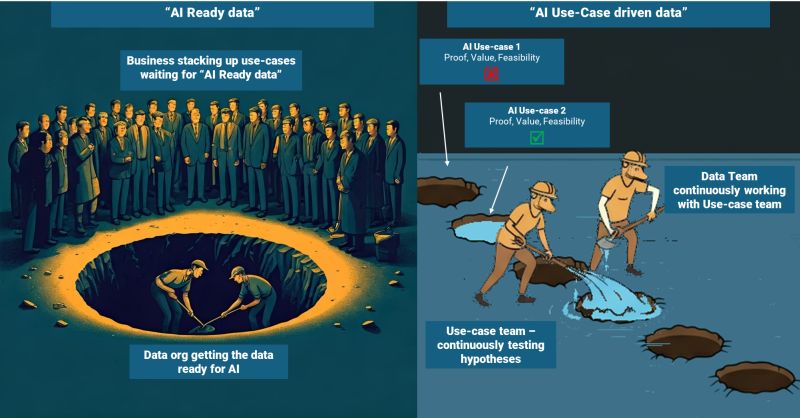The Myth of "AI-Ready Data"
One of the biggest misconceptions in AI is the belief that data needs to be "AI-ready" before organizations can successfully implement AI solutions. This is completely backwards.
In reality, AI-readiness starts with the use case, not the data. You don’t truly know whether your data will support a hypothesis until you test it. AI success isn’t about perfect data; it’s about having a repeatable process for experimentation, validation, and deployment.
At Dataception Ltd, we’ve run countless AI proof-of-concepts (PoCs). Some have succeeded, some have "failed"—but we put failed in quotes because failure is an expected part of the AI process. It’s how businesses learn what works, refine their approach, and ultimately find real value.
AI Success = Rapid, Low-Cost Experimentation
If you want AI to drive value, you need a system that allows you to:
✔ Run AI experiments quickly—Days or weeks, not months
✔ Minimize costs and resources—1-2 people, not entire teams
✔ Validate hypotheses before committing to large-scale implementation
We've built highly effective AI solutions using what traditional data professionals would consider low-quality data—even datasets with high noise, missing values, or inconsistencies. The key isn’t perfection, it’s pattern recognition. AI only needs enough of a pattern to deliver useful insights.
Example: We once built an AI model using 75,000 rows of data where 30,000 were garbage—and still achieved a strong, usable outcome.
The Three AI Validation Pillars
Before moving AI models into production, organizations should validate:
1️⃣ Proof—Does the AI model support our hypothesis? (e.g., "Our orders are dropping because of X.")
2️⃣ Value—Does the solution provide measurable business benefits? (e.g., "If we implement this, we can save Y.")
3️⃣ Feasibility—Do we have the right data, resources, and infrastructure to support the solution?
Some AI experiments will pass all three tests. Some won’t. The key is to move through this process quickly, frequently, and at minimal cost.
Why Many AI Initiatives Fail (and How to Fix It)
Many businesses abandon AI after a single failure, often due to:
❌ Excessive cost & time investment—6+ months, hundreds of thousands to millions in sunk costs
❌ Misaligned expectations—One failed experiment leads leadership to conclude that "AI doesn’t work for us"
❌ Lack of iteration—AI was treated as a one-time project rather than an ongoing process
🚀 The Fix: AI needs to be embedded as a continuous capability—not just a one-off project.
AI Models Are High-Maintenance Pets—Treat Them Accordingly
AI models aren’t static—they require constant monitoring, updates, and tuning. A successful AI-driven organization continuously:
🔄 Experiments and iterates on new ideas
⚡ Deploys and tests quickly in real business environments
📈 Learns from failures and adjusts accordingly
A great example of AI failure due to lack of iteration? McDonald’s drive-thru voice AI, which struggled with real-world nuances. The problem wasn’t AI itself—it was the lack of a structured, ongoing refinement process.
Unlocking AI’s True Potential
If you’re thinking, “We need a massive project and a big team to get AI right,” think again.
✅ Start small. Validate a use case quickly.
✅ Iterate fast. If it works, scale. If not, pivot.
✅ Make AI a continuous capability. Not a one-time initiative.

At Dataception Ltd, we've been leading AI transformation projects since 2017, using AI and Data Products to help businesses discover real value—"The Treasure."
📢 Watch this space for more insights. If you’re interested in embedding AI as a core part of your business strategy, let’s talk. 🚀

